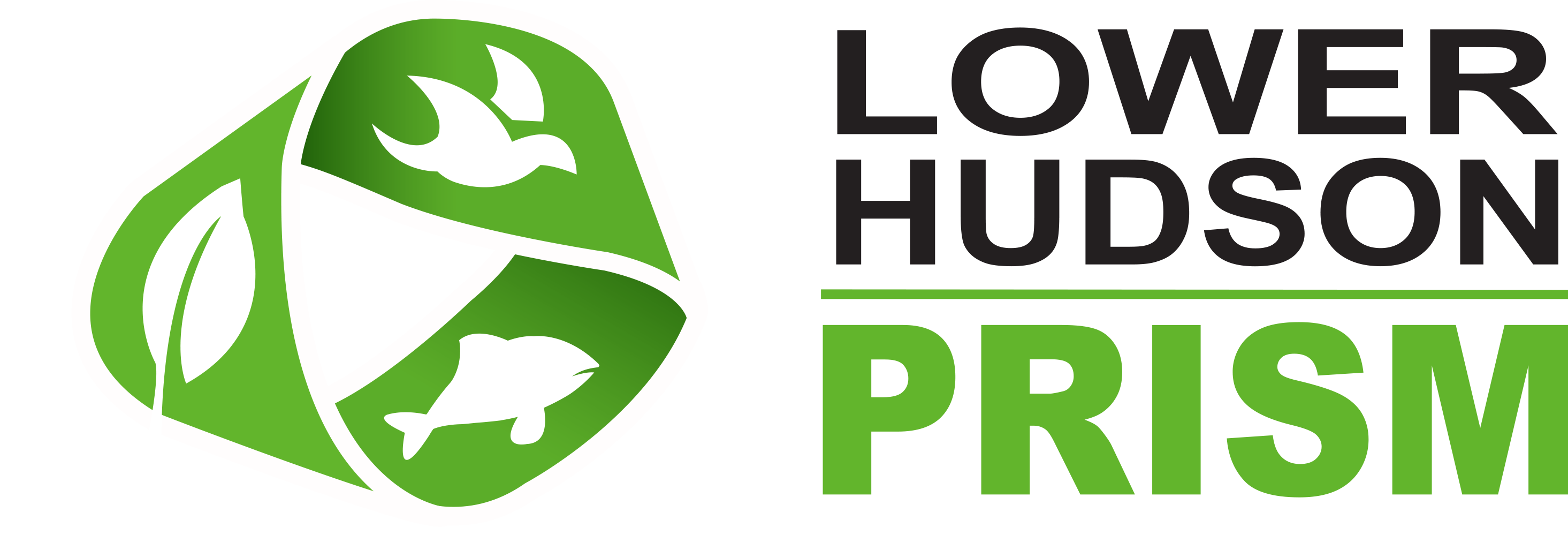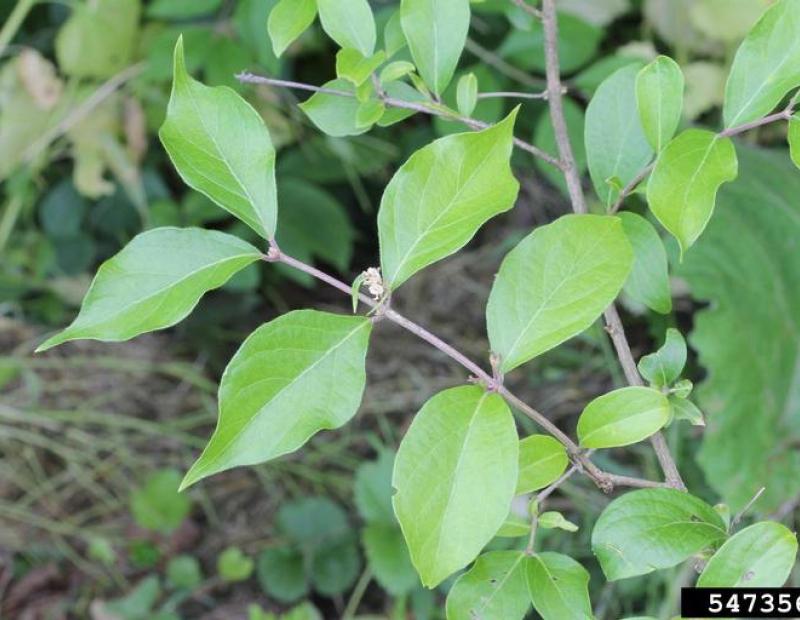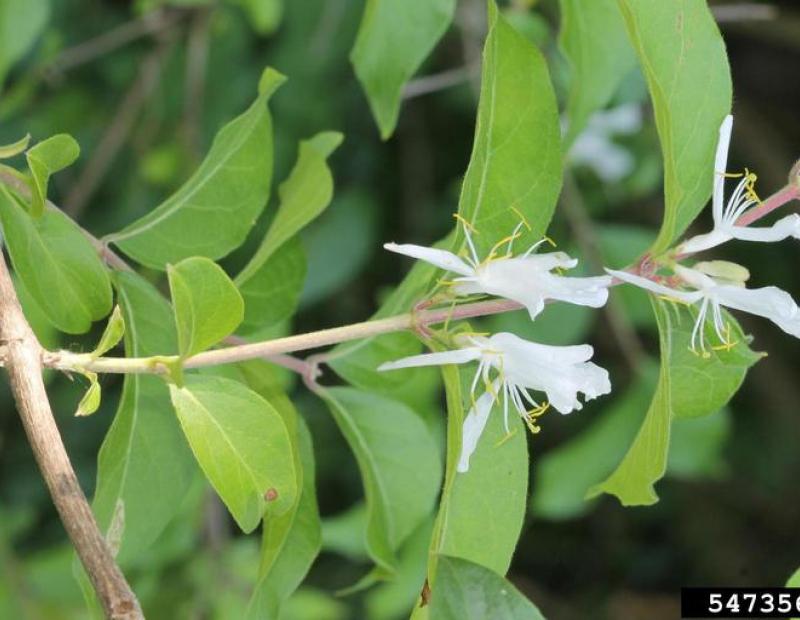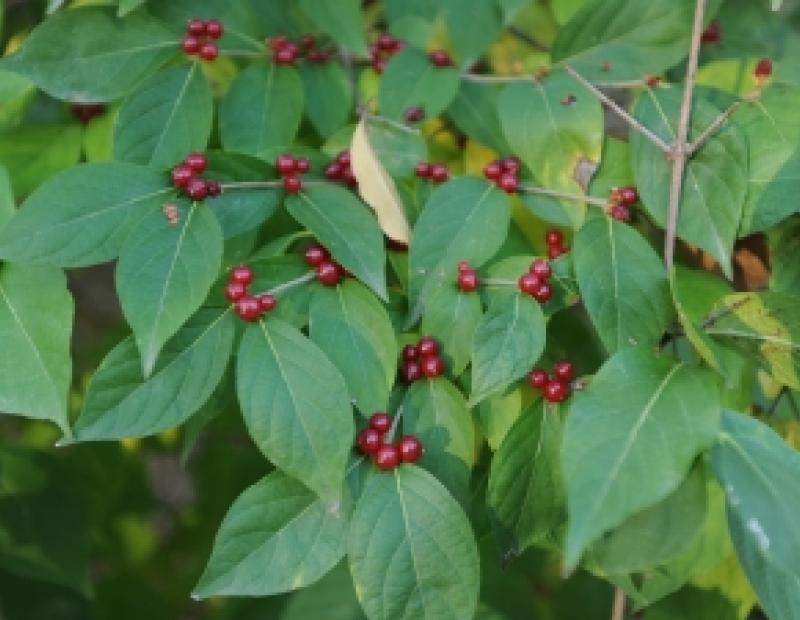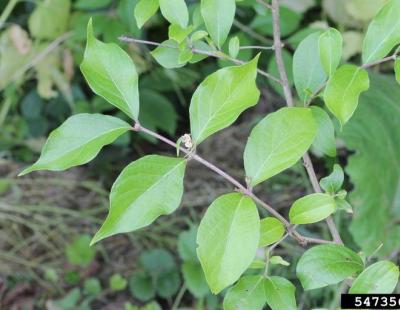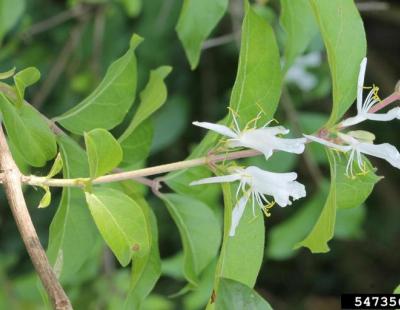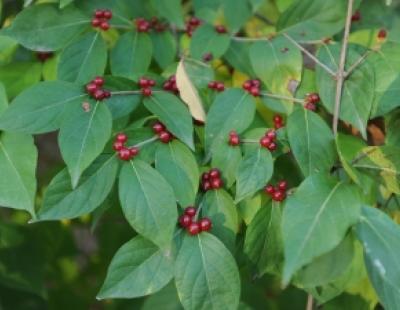Vertical Tabs
Amur honeysuckle is a member of the Honeysuckle family (Caprifoliaceae). Amur honeysuckle is a tall, robust shrub growing up to 20 feet in height. This species is most conspicuous in summer, when fragrant gold and white-pinkish trumpet-shaped blooms appear, and early Autumn when bright red, circular berries cover the plant. (4) Key identifying characteristics Amur honeysuckle is easily confused with the plethora of other honeysuckles Amur honeysuckle is a member of the Honeysuckle family (Caprifoliaceae). Amur honeysuckle is a tall, robust shrub growing up to 20 feet in height. This species is most conspicuous in summer, when fragrant gold and white-pinkish trumpet-shaped blooms appear, and early Autumn when bright red, circular berries cover the plant. (4)
Leaves
As with all honeysuckles, this species’ leaves are oppositely arranged. Leaves are lightly hairy, dark green above and pale below, and have long, pointy tips. (4)
Flowers
Flowers are trumpet-shaped, and white-pinkish in color, situated in the leaf axils and fade to gold/yellow with age. (4)
Fruit/Seed
Fruit is a bright red translucent berry, appearing in late summer to early fall. (4)
Amur honeysuckle is a wide-ranging invasive species, occurring across North America. Research has determined this common invasive has dramatic ecological impacts on the communities it invades, including causing major alterations in soil microbiota, decomposition rates, vegetation community structure, and light availability. 12
Biological Control
No biological control option is currently available for this species.
Manual or Mechanical Control
Pulling / Digging Up: Hand pulling or digging small seedlings or plants is effective. For larger shrubs, use of a weed wrench is recommended. If undertaking this management method without the use of herbicides, a commitment to pull at least once a year for 3-5 years is necessary to achieve any measure of control. (7)
Mowing: Mowing or weed whacking can prevent plants from flowering and fruiting if begun in spring and continued in regular intervals. Winter cutting should be avoided as it promotes vigorous re-sprouting. (7)
Girdling: Not advisable unless used in tandem with repeated cutting, or foliar spray. Girdling of larger shrubs will encourage re-sprouting. (7)
Prescribed Fire: Controlled burns can kill seedlings or small plants and will top kill larger individuals. This method of management is not very effective and must be used annually. (7)
Torching: Torching is effective in small populations or on seedlings. (7)
Prescribed Grazing: Although deer do graze Amur honeysuckle, bitter compounds in its tissues deter most livestock. (12)
Soil Tilling: Tilling is effective on smaller individuals but may not be an appropriate management method in most natural areas.
Mulching: No information available
Solarization: No information available
Hot Foam Spray: No information available
Chemical Control
Foliar Spray: A 1-2% solution of glyphosate is effective against this species. Always read and follow all directions on the herbicide label. (8)
Cut Stump: Larger stems can be effectively controlled by cutting in spring and immediately applying a 20% solution of glyphosate or triclopyr. All treated plants should be monitored for re-sprouting in 2-3 weeks and in the following growing season. (8)
Basal Bark: A 25% solution of triclopyr applied to the bark of dormant Amur honeysuckle is somewhat effective at controlling infestations, although this technique is best applied with other strategies, such as a follow-up cut stump. (9)
Cut and Frill: Apply a 50% solution of glyphosate or triclopyr to cuts in Amur honeysuckle’s cambium.
Stem Injection: Injecting stems towards the end of the growing season with a 50% solution of glyphosate has up to a 98% kill rate. (10)
Pre-Emergent Spray: Pre-emergent spray: Pre-emergent spray containing sulfometuron methyl is effective on germinating seedlings. This method of management should be used in combination with a foliar spray during the growing season, such as glyphosate. (11)
The pesticide application rates and usage herein are recommendations based on research and interviews with land managers. When considering the use of pesticides, it is your responsibility to fully understand the laws, regulations and best practices required to apply pesticides in a responsible manner. At times, the pest you seek to treat may not be listed on a pesticide label, requiring a 2(ee) exemption from NYSDEC. Always thoroughly read the label of any pesticide and consult the NYSDEC or a licensed pesticide applicator with questions.
General management overview and recommendation
As with any other invasive infestation complex, large aggregations of Amur honeysuckle are best managed via a combination of mechanical and chemical means. Hand pulling of seedlings and small plants should be accompanied by cutting and herbicide application of larger shrubs in order to attain good control. All managed infestations should be monitored to ensure adequate revegetation of the controlled area and that re-invasion does not occur. Any new seedlings can be hand pulled.
Post treatment monitoring
Controlled populations should be revisited at least once the following season to ensure no new seedlings are present.
Disposal Methods
All populations should be managed prior to seed set to reduce likelihood of regeneration. Managed material should be chipped and can be composted, provided no viable seed is present on plant material
REFERENCES
- https://www.dec.ny.gov/docs/lands_forests_pdf/isprohibitedplants2.pdf
- https://www.cabi.org/isc/datasheet/31192
- https://plants.usda.gov/core/profile?symbol=loma6
- https://www.cabi.org/isc/datasheet/31192
- https://gobotany.newenglandwild.org/species/lonicera/morrowii/
- https://www.fs.fed.us/database/feis/plants/shrub/lonspp/all.html
- https://www.invasive.org/gist/esadocs/documnts/loni_sp.pdf
- https://mdc.mo.gov/trees-plants/problem-plant-control/invasive-plants/bu...
- http://tnipc.org/invasive-plants/plant-details/?id=25
- https://weedscience.ca.uky.edu/files/bushhoneysuckledormant2005_0.pdf
- https://www.extension.purdue.edu/extmedia/FNR/FNR-224-W.pdf
- https://cees.iupui.edu/blog/amur-honeysuckle-why-we-care
